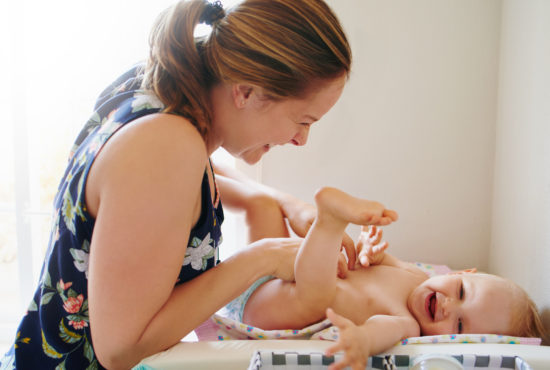Putting a nappy on a newborn baby is a skill that new parents will quickly get a lot of practise in. Every NCT Antenatal course will cover how to change a nappy with practise on a doll – for many this might be their first experience of a nappy change! NCT Antenatal Practitioner Caroline Graham answers some commonly asked questions…

The average weight of a newborn baby in the UK is 7lb 8oz for boys and 7lb 4oz for girls. All disposable nappies will have a suggested baby weight on the packet, for example: Size 1 nappies are for babies 2-5kg or 4-11lbs.
These would therefore be suitable for the average baby and are likely to be the correct size for the first few weeks.
There are also Size 0 nappies designed for babies weighing less than 3kg (6lb 6oz) and these may be a better fit for smaller babies. Most parents recognise that they need to move up a nappy size when they find the nappy feels small around their baby or they notice more leaks.
Parents attending our Antenatal courses can access a discount offer to purchase Lupilu nappies and select other products from Lidl via our Parent Hub website.
Expectant parents often want to know how many nappies to buy in preparation for having a baby and it is certainly worth having a few packs of size 1 nappies stockpiled.
You may wish to have a few of the size 0 nappies for the very early days and you can always donate any spares to other expectant parents, or your local foodbank or maternity unit if your baby grows out of them before you have used up the packet.
Babies feed frequently throughout the day and night. They are used to receiving constant nourishment in the womb and have small stomachs. Not to mention feeding is an opportunity for lots of cuddles – which babies love.

As a result they wee and poo frequently – which is a good thing because it’s the best way of knowing your baby is getting enough milk. Whilst a tiny wee in a nappy might not need an immediate change, if your baby has done a poo then it can cause nappy rash if not cleaned up.
The number of nappy changes may therefore depend on the number of poos that a baby does throughout the day. Some babies may go little and often and some may save it up for a nappy explosion, commonly known as a poonami!
The NHS suggests that young babies may need their nappy changing between 10-12 times a day reducing to 6-8 times a day as babies get older.
Nappy changes are not just about keeping babies clean and smelling nice (although that is important!)
It’s a great opportunity to engage with your baby
Every nappy change is an opportunity to interact with your baby, to talk to them about what is happening so they learn language, to show love through gentle touch and to show them how their bodies move to help them gain motor skills.
The next time you do a nappy change watch how your baby looks at you. Even a very young baby will track your movement, be drawn to your facial expressions and be listening to the tone of your voice.

Considering the amount of nappy changes that can happen during a day with a newborn it is a great opportunity to engage with your baby. You could sing them a song, describe the patten on the change mat or wall, massage their feet or simply talk them through what you are doing.
Babies are constantly learning from what goes on around them and what may feel like a repetitive chore is an opportunity for babies to learn. By changing a nappy a baby may learn that they are safe, loved and cared as well as ending up with a clean bottom too.
On our Antenatal courses, course leaders support parents to learn how to put a nappy on and give them some helpful tips, using Lidl’s Lupilu nappies. We also have a ‘What’s in a nappy’ hand out to help parents recognise what’s normal, and if feeding is going well.
We’ve got lots of tips on our website about how to look after your newborn baby, from bathing to baby massage. Take a look here.
If you’re wondering what’s normal and what’s not, you might find it useful to look at our article on the contents of your baby’s nappy in the early days.